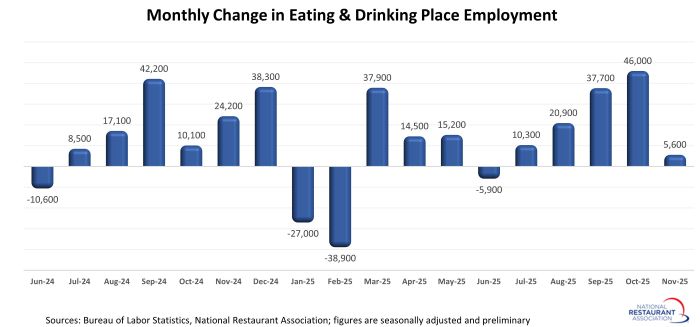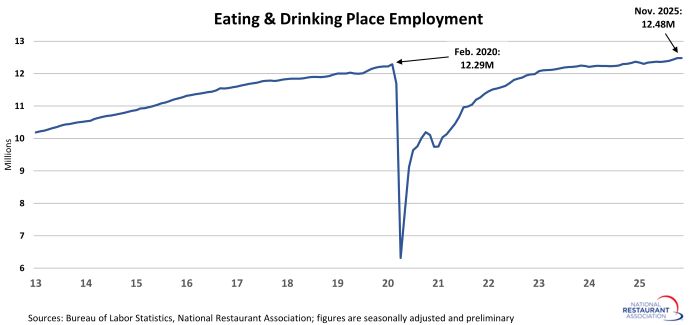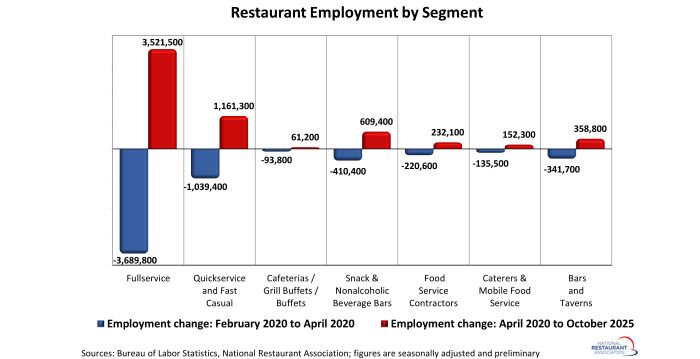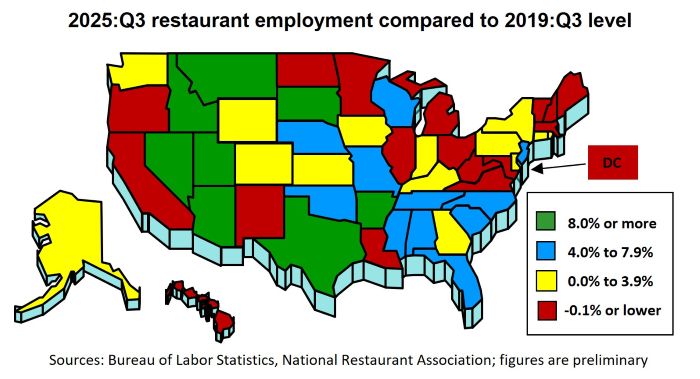Research
December 16, 2025
Total restaurant industry jobs
Restaurants added jobs for the 5th consecutive month in November
Restaurant operators expanded payrolls in recent months, even as business conditions remained challenging.
Eating and drinking places* added a net 5,600 jobs in November on a seasonally-adjusted basis, according to preliminary data from the Bureau of Labor Statistics (BLS). While that was well below the strong gain of 46,000 jobs in October, it represented the 5th consecutive monthly increase in restaurant jobs.
Overall during the past 5 months, eating and drinking places added more than 120,000 jobs. That was a solid improvement from the choppy first half of 2025, when the industry lost a net 4,200 jobs.
The restaurant industry’s reacceleration of job growth contrasted with the recent trends in the overall economy. The nation’s private sector employers added an average of 58,000 jobs during the last 5 months, which was down from an average monthly gain of nearly 80,000 jobs during the first half of the year.

The recent uptick in restaurant job growth propelled the size of the industry workforce to new record highs. As of November 2025, eating and drinking place employment was more than 196,000 jobs (or 1.6%) above its February 2020 level.

Fullservice segment posted strongest job growth in recent months
The fullservice segment registered the strongest employment growth in recent months, particularly following the industry’s job losses during the first 2 months of 2025.
Fullservice restaurants added a net 88,400 jobs between February and October on a seasonally adjusted basis. That was more than double the 42,100 jobs added at snack and nonalcoholic beverage bars – the next closest segment.
Despite the recent gains, the fullservice segment remains 168,000 jobs (or 3.0%) below pre-pandemic levels.
Employment in the limited-service segments recovered much faster from the pandemic-induced job losses. As of October 2025, employment at snack and nonalcoholic beverage bars – including coffee, donut and ice cream shops – was 199,000 jobs (or 24.6%) above February 2020 readings.
Employee counts at quickservice and fast casual restaurants were 122,000 jobs (or 2.7%) above pre-pandemic levels.
[Note that the segment-level employment figures are lagged by one month, so October 2025 is the most current data available.]
Restaurant job growth uneven across states
More than 5 years after the onset of the pandemic in the U.S., restaurant staffing levels remain below pre-pandemic readings in 17 states and the District of Columbia.
This group was led by Massachusetts, Illinois, West Virginia, Maryland and California, which had about 3% fewer eating and drinking place jobs in the third quarter of 2025 than they did in the third quarter of 2019. Michigan, Minnesota and Vermont remained about 2% below their pre-pandemic restaurant employment levels.
In contrast, restaurant employment in several of the mountain states has climbed well beyond pre-pandemic levels. This group is led by Idaho (+20%), South Dakota (+19%), Utah (+15%) and Nevada (+14%).
[Note that the state-level analysis uses 2019 as the pre-pandemic comparison instead of February 2020, because seasonally-adjusted employment figures are not available for every state.]
View the latest employment data for every state.

Note: Eating and drinking places are the primary component of the total restaurant and foodservice industry, providing jobs for roughly 80% of the total restaurant and foodservice workforce of more than 15.7 million.
Track more economic indicators and read more analysis and commentary from the Association's economists.
Eating and drinking places* added a net 5,600 jobs in November on a seasonally-adjusted basis, according to preliminary data from the Bureau of Labor Statistics (BLS). While that was well below the strong gain of 46,000 jobs in October, it represented the 5th consecutive monthly increase in restaurant jobs.
Overall during the past 5 months, eating and drinking places added more than 120,000 jobs. That was a solid improvement from the choppy first half of 2025, when the industry lost a net 4,200 jobs.
The restaurant industry’s reacceleration of job growth contrasted with the recent trends in the overall economy. The nation’s private sector employers added an average of 58,000 jobs during the last 5 months, which was down from an average monthly gain of nearly 80,000 jobs during the first half of the year.

The recent uptick in restaurant job growth propelled the size of the industry workforce to new record highs. As of November 2025, eating and drinking place employment was more than 196,000 jobs (or 1.6%) above its February 2020 level.

Fullservice segment posted strongest job growth in recent months
The fullservice segment registered the strongest employment growth in recent months, particularly following the industry’s job losses during the first 2 months of 2025.
Fullservice restaurants added a net 88,400 jobs between February and October on a seasonally adjusted basis. That was more than double the 42,100 jobs added at snack and nonalcoholic beverage bars – the next closest segment.
Despite the recent gains, the fullservice segment remains 168,000 jobs (or 3.0%) below pre-pandemic levels.
Employment in the limited-service segments recovered much faster from the pandemic-induced job losses. As of October 2025, employment at snack and nonalcoholic beverage bars – including coffee, donut and ice cream shops – was 199,000 jobs (or 24.6%) above February 2020 readings.
Employee counts at quickservice and fast casual restaurants were 122,000 jobs (or 2.7%) above pre-pandemic levels.
[Note that the segment-level employment figures are lagged by one month, so October 2025 is the most current data available.]

Restaurant job growth uneven across states
More than 5 years after the onset of the pandemic in the U.S., restaurant staffing levels remain below pre-pandemic readings in 17 states and the District of Columbia.
This group was led by Massachusetts, Illinois, West Virginia, Maryland and California, which had about 3% fewer eating and drinking place jobs in the third quarter of 2025 than they did in the third quarter of 2019. Michigan, Minnesota and Vermont remained about 2% below their pre-pandemic restaurant employment levels.
In contrast, restaurant employment in several of the mountain states has climbed well beyond pre-pandemic levels. This group is led by Idaho (+20%), South Dakota (+19%), Utah (+15%) and Nevada (+14%).
[Note that the state-level analysis uses 2019 as the pre-pandemic comparison instead of February 2020, because seasonally-adjusted employment figures are not available for every state.]
View the latest employment data for every state.

Note: Eating and drinking places are the primary component of the total restaurant and foodservice industry, providing jobs for roughly 80% of the total restaurant and foodservice workforce of more than 15.7 million.
Track more economic indicators and read more analysis and commentary from the Association's economists.